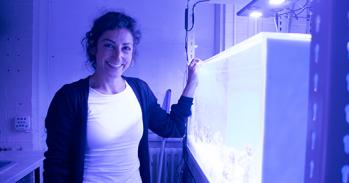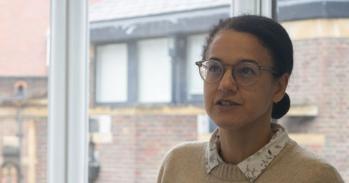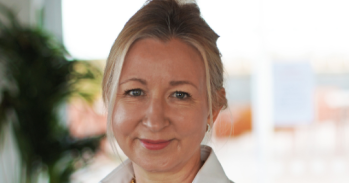
The study of plants is blossoming in Cambridge, with new facilities, new research and soon a major new institute.
The study of plants is blossoming in Cambridge, with new facilities, new research and soon a major new institute.
Increasingly, plants are recognised as being at the heart of sustainable solutions to many global concerns.
Increasingly, plants are recognised as being at the heart of sustainable solutions to many global concerns, whether it’s the need to secure food supplies, develop biofuels or tackle environmental issues. ‘Plant-related research is now much more prominent as a result of this new awareness,’ said Professor Sir David Baulcombe, Head of the Department of Plant Sciences and first incumbent of the newly created Regius Professorship of Botany. ‘We want to be in a position in Cambridge to step up to the mark and generate the understanding and applications needed to meet these challenges.’
Fortunately, Cambridge has a strong record in the study of plants, a record that is being strengthened by funding for new facilities and research in the Department of Plant Sciences, and by the ongoing construction of the Sainsbury Laboratory in the University’s Botanic Garden.
A long-term refurbishment programme within the Plant Science buildings in the centre of Cambridge has seen the addition of wet and dry research laboratories on two floors of the building. Three new Royal Society Research Fellows in the Department have been funded by £2 million from The Gatsby Charitable Foundation, which has also provided £2 million support for Professor Baulcombe’s research.
Added to this are the two new buildings. A £6 million Plant Growth Facility situated in the Botanic Garden, funded by the Science Research Investment Fund and The Gatsby Charitable Foundation, has provided much-needed space for cultivating and studying plants under controlled environmental conditions. Due for completion later this year is the magnificent Sainsbury Laboratory, which has been made possible through a gift by The Gatsby Charitable Foundation of £82 million, the largest single gift received by the University since the launch of the 800th Anniversary Campaign.
From forests to fragments
The study of plants has been transformed by the resources now available to biologists. In the Department of Plant Sciences, engineering principles are being applied to plant development and behaviour; computer modelling yields vast datasets on the spread of plant viruses or of genetically modified crops; sophisticated genetic tools and high-volume DNA sequencing are giving insight into how plant cells function and how they can be modified; and refined chemical approaches are opening up new routes for generating energy from plants.
The exceptional breadth of research doesn’t reach just from genetics to biochemistry, and from evolution to ecology, but also from gigantic to miniscule. One example of the larger-scale research being undertaken in the Department is Dr Ed Tanner’s work on the Panamanian rainforest. For the past decade, Dr Tanner’s group has been looking at the effects of climate change on carbon and nutrient fluxes in lowland tropical rainforest.
Elevated CO2 in the atmosphere increases the growth of trees, which produce more leaves that eventually fall from the canopy to the forest floor. Dr Tanner’s research group has demonstrated that this additional leaf fall has the net effect of mobilising carbon that was stored in the soil. ‘These data have environmental implications since they show that carbon in tropical soil is in dynamic equilibrium and that additions of carbon can destabilise some of the soil organic matter, causing increased release of CO2’.
At the other end of the size range, many research groups aim to understand how plant cells work at the molecular scale. For example, research in Professor Baulcombe’s group investigates how plants regulate gene expression, and in particular the molecular mechanisms that enable plants to become disease resistant. ‘We have shown how the presence of small fragments of the genome of an infecting virus in a plant cell guide a plant protein to newly infecting virus genomes and silence them, stopping the plant from being re-infected by the same virus.’
Professor Baulcombe’s work on this mechanism of gene silencing, and the small interfering RNA molecules that achieve it, has been honoured several times over: the 2008 Lasker Award for Basic Medical Research, and this year’s Wolf Foundation Prize in Agriculture and the Harvey Prize. As well as providing new opportunities for engineering disease resistance in plants of agricultural value, gene silencing offers a tool for turning genes on and off in plants to help determine their function.
Plants for food and fuel
The United Nations Food and Agricultural Organization has forecast that global food production will need to increase by over 70% by 2050 to feed the growing population. As more emphasis is placed on the role of plant science in providing long-term, sustainable answers, Cambridge researchers are investigating diverse areas that have applications in food security: how plant yields can be improved; how disease and pests can be controlled; and how plants can be re-modelled, for instance to adapt to growing in new environments.
Dr Julian Hibberd, named last year by Nature magazine as ‘one of five crop researchers who could change the world’, is working with a worldwide consortium of experts whose goal is to re-engineer rice to increase yields dramatically. With funding from the Bill & Melinda Gates Foundation, Dr Hibberd’s team is taking the pioneering approach of attempting to change the photosynthetic pathway used by rice into a more efficient pathway found in plants such as maize.
The procedure is challenging but could reap great dividends, as Dr Hibberd explained: ‘It’s likely that dozens of genetic alterations will be needed to change the biochemistry, anatomy and biology of rice, but if we can produce higher-yielding rice this could dramatically alleviate potential food shortages of the future.’
Plants are also important as part of the spectrum of future energy resources. In the search for plant-based solutions, Cambridge’s Algal Bioenergy Consortium (ABC) is turning to algae, simple aquatic organisms from which the first land plants evolved 400 million years ago. ‘On many levels, algae make an excellent choice as a source of biofuel,’ explained Professor Alison Smith, one of the founders of the ABC. ‘Many species grow rapidly, can produce high levels of fuel molecules, and they are not a food crop.’
The ABC is bringing together Cambridge-based algal physiologists and molecular biologists with engineers and chemical engineers, and is also working with industrial partners to test ideas that arise at the laboratory bench. One area of current investigation is the use of photovoltaic cells that ‘steal’ electrons from the algal photosynthetic process as a source of energy.
A new development: the Sainsbury Laboratory
The Sainsbury Laboratory will provide state-of-the-art laboratory facilities for 120 scientists and 30 support staff dedicated to finding out how complex plants develop from a single egg cell, and to understanding how the information coded in their DNA leads to their growth and form – fundamental knowledge for understanding evolution and for improving crops. Together, research in the Laboratory and the Department of Plant Sciences will afford an enormously broad and integrated understanding of plants in Cambridge.
The Laboratory will also provide a new home for the University Herbarium, a unique collection begun by Professor John Stevens Henslow in 1821 and now containing a million specimens of historic and current research value. ‘In effect,’ said Professor John Parker, Curator of the Herbarium and Director of the Botanic Garden, ‘the Herbarium is returning home, to the Botanic Garden that was founded by Henslow over 160 years ago.’
At the ground-breaking ceremony for the new Laboratory last year, Lord Sainsbury, founder of The Gatsby Charitable Foundation, said: ‘This is one of the most exciting projects with which my Charitable Foundation has been involved. It combines an inspirational research programme, an historic site in the Botanic Garden and a beautiful laboratory designed by Stanton Williams, and I believe it will soon become a world-class centre of excellent plant science.’
‘The new developments represent wonderful research opportunities,’ said Professor Baulcombe. ‘Not just for plant scientists in Cambridge but for underpinning much-needed information for progress in agriculture, energy and the conservation of biodiversity.’
For more information about research at the Department of Plant Sciences, please visit www.plantsci.cam.ac.uk/
This work is licensed under a Creative Commons Licence. If you use this content on your site please link back to this page.





